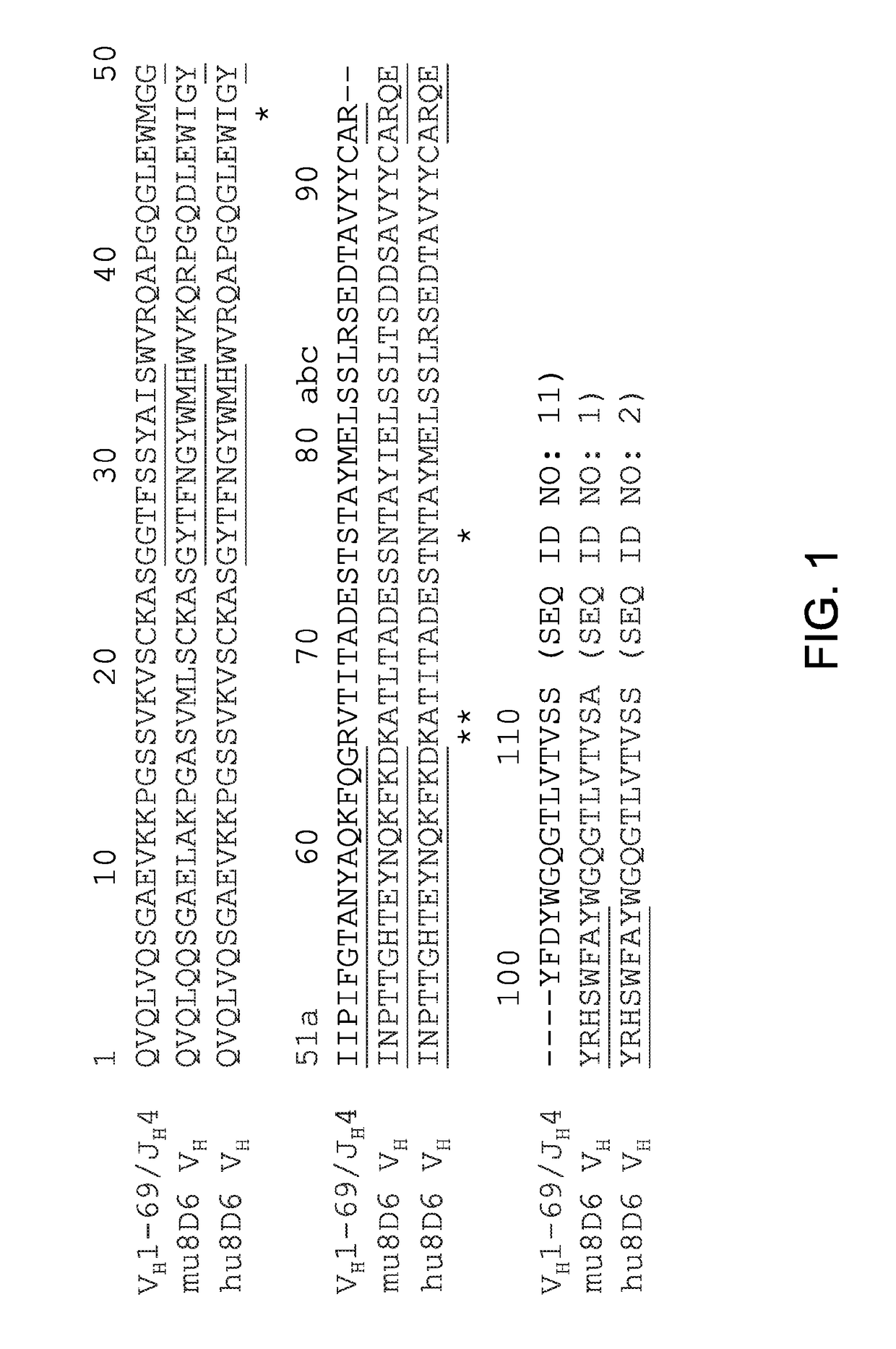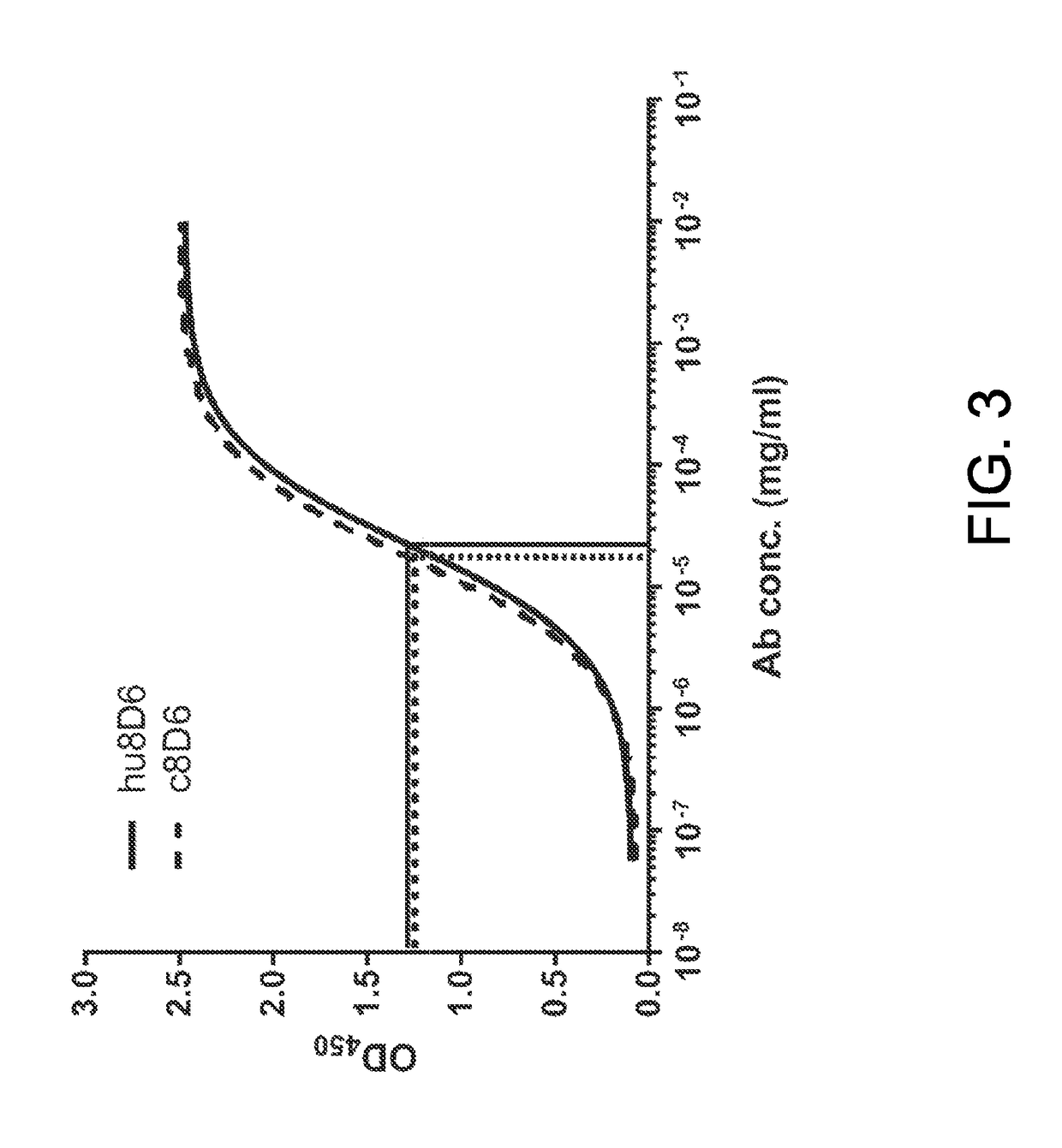Humanized anti-IgE antibodies that crosslink CD23 on B lymphocytes but do not sensitize mast cells
a technology of b lymphocytes and humanized antibodies, applied in the field of humanized antibodies, can solve the problems of limited application of murine antibodies for treating ige-mediated diseases, immunogenic murine antibodies, and limited human murine antibodies, so as to facilitate mopping and removal, improve the effect of ige-mediated symptoms and reduce the effect of immunogenic antibodies
- Summary
- Abstract
- Description
- Claims
- Application Information
AI Technical Summary
Benefits of technology
Problems solved by technology
Method used
Image
Examples
example 1
Generation of a Humanized Anti-IgE Antibody
[0047]CDR Grafting
[0048]The amino acid sequence of VH (SEQ ID NO: 1) and Vκ (SEQ ID NO: 3) domains from 8D6 were aligned with those of the human germline VH1-69 / JH4 and Vκ1-39 / Jκ1 alleles. To make the CDR graft, the acceptor VH framework, which differs from the human germline VH1-69 allele at 4 positions M481, R66K, V67A, and S76N, was used. The CDRs, which are position 26-35 (CDR-H1, SEQ ID NO: 5), 50-56 (CDR-H2, SEQ ID NO: 6), and 93-104 (CDR-H3, SEQ ID NO: 7) of 8D6 were engineered into the acceptor VH framework to generate a direct CDR-graft of 8D6 VH as shown in FIG. 1. In the Vκ domain, the CDRs of positions 27-34 (CDR-L1, SEQ ID NO: 8), 50-56 (CDR-L2, SEQ ID NO: 9), and 89-97 (CDR-L3, SEQ ID NO: 10) were grafted to the acceptor Vκ framework, which differs from the human germline Vκ1-39 allele at a position M4L (FIG. 2). The direct CDR-graft of 8D6 VL was referred to as hu8D6 VL (SEQ ID NO: 4).
[0049]IgG Production
[0050]In order to obt...
example 2 inability
of hu8D6 to Bind to Human FcεRI-Bound IgE
[0060]Inability of hu8D6 to Bind to IRE-Saturated Recombinant Chain of Human FcεRI
[0061]ELISA was used to determine the binding of hu8D6 to solid-phase recombinant FcεRIα fusion protein (huFcεRIα-huFcγ1, referred to FcεRIα-Fc), which was composed of the extracellular region of human FcεRIα (from Val26 to Leu204) and the hinge-CH2-CH3 portion of human γ1 (Shiung et al., Immunobiology, 2012, 217:676-683). The FcεRIα-Fc protein was expressed by the FreeStyl™ 393F system (Invitrogen) and purified by protein A chromatography. The wells of ELISA plates were coated with 2 μg / mL of FcεRIα-Fc in coating buffer at 4° C. overnight and treated with assay diluents (0.5% BSA, 0.05% Tween-20, 0.01% thimerosal in PBS) for 1 hour at room temperature. The coated FcεRIα-Fc proteins were then saturated with 1 μg / mL IgE, which was purified from the culture medium of U266 cells by anti-IgE chromatography. After the wells were washed 6 times with wash buffer, the c...
example 3 inability
of hu8D6 to Sensitize RBL SX-38 Cells
[0068]The extent of degranulation was assessed by measuring the release of β-hexosaminidase, a lysosomal enzyme stored in granules, into the culture medium. RBL SX-38 cells were seeded in a 24-well plate at 3×105 cells / well in 0.5 mL of culture medium overnight in at 37° C. On the next day, the medium was removed and 0.25 mL of pre-warmed culture medium containing 1 μg / mL human IgE was added to each well. After 2 hour of incubation in a 37° C. incubator, each well was washed twice with 0.5 mL of Tyrode's buffer (135 mM NaCl, 5 mM KCl, 5.6 mM glucose, 1.8 mM CaCl2, 1 mM MgCl2, 20 mM HEPES, and 0.5 mg / mL BSA, pH 7.3) and then 0.25 mL of pre-warmed Tyrode's buffer containing 10, 1, 0.1, or 0.01 μg / mL of antibodies or 1% Triton X-100 added. After a 30 minutes incubation in a 37° C. incubator, the supernatants were collected and centrifuged at 300×g for 5 minutes at room temperature and 50 μL clear supernatants were transferred from each well to that ...
PUM
| Property | Measurement | Unit |
|---|---|---|
| molecular weight | aaaaa | aaaaa |
| pH | aaaaa | aaaaa |
| pH | aaaaa | aaaaa |
Abstract
Description
Claims
Application Information
 Login to View More
Login to View More - R&D
- Intellectual Property
- Life Sciences
- Materials
- Tech Scout
- Unparalleled Data Quality
- Higher Quality Content
- 60% Fewer Hallucinations
Browse by: Latest US Patents, China's latest patents, Technical Efficacy Thesaurus, Application Domain, Technology Topic, Popular Technical Reports.
© 2025 PatSnap. All rights reserved.Legal|Privacy policy|Modern Slavery Act Transparency Statement|Sitemap|About US| Contact US: help@patsnap.com



